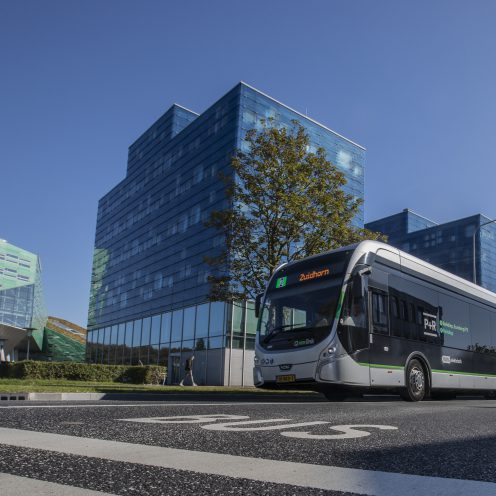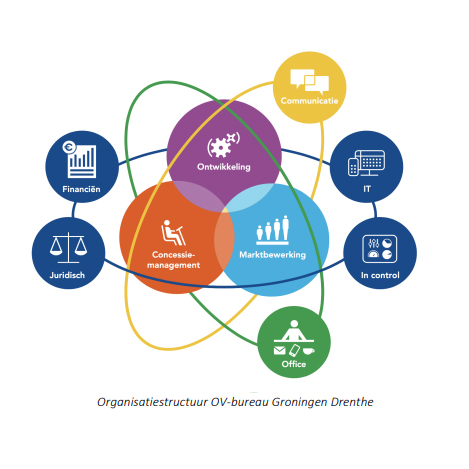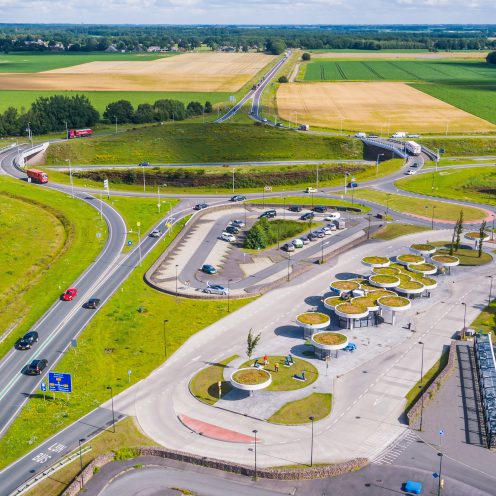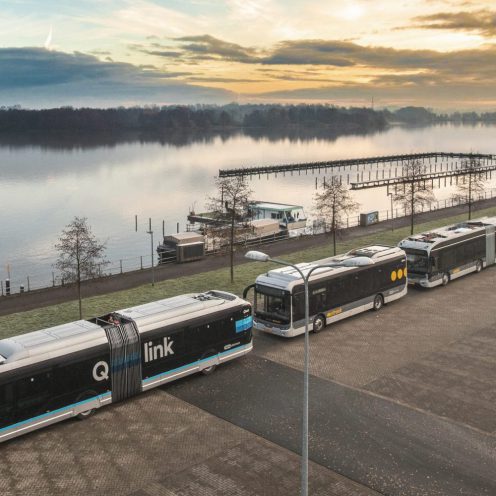The OV-bureau (public transport authority)
The OV-bureau was founded in 2004 by the provinces of Groningen and Drenthe and the municipality of Groningen in order to collectively fulfil the task of commissioning public (bus) transport. The idea behind the cooperation was to join forces in order to create transport, social and financial added value for public transport in the area. Public (bus) transport is an important part of the broader traffic and transport policy in the region.
The OV-bureau as director
The OV-bureau plays the role of director and guards public goals in public transport that must be realised (availability, reachability, accessibility and so on). The OV-bureau has to work within the set financial framework and is responsible for public transport development and traveler revenue. The execution of the travel service lies with the public transport company.

Our mission
The mission of the OV-bureau is to realize, maintain and improve a future-proof and accessible mobility system. This system aims to make and keep the rural area and the cities accessible. In addition, public transport must be affordable for both the traveler and the government and remain to be so.
This mission is broader than just bus transport and what the OV-bureau can achieve independently. That is why it is important that the OV-bureau works together with partners such as the government, provinces, municipalities, transporters, companies, educational institutions and other organisations that can help to realise its mission.
General board
The strategic policy of the OV-bureau is determined by the general board. In addition, the general board annually determines the budget and the annual accounts. The general board consists of administrators from the provinces of Groningen and Drenthe and the city of Groningen. These are:
Henk Jumelet
provincie Drenthe
Willemien Meeuwissen
provincie Drenthe
Yvonne Turenhout
provincie Drenthe
Rik van Niejenhuis
gemeente Groningen
Inge Jongman
gemeente Groningen
Philip Broeksma
gemeente Groningen
Erik Jan Bennema
provincie Groningen
Karin Dekker
provincie Groningen
Pascal Roemers
provincie Groningen
The executive board
In addition to the general board, there is the executive board, which is responsible for preparing and executing decisions of the general board. In addition, the executive board is responsible for drawing up and establishing the tender documents for public transport tenders and granting, changing or withdrawing concessions for the provision of public transport. The executive board of the OV-bureau consists of three directors. The director of the OV-bureau is secretary of the executive board.
Rosalinde Hoorweg
Secretaris
Philip Broeksma
Erik Jan Bennema
Voorzitter
Henk Jumelet
Financial accountability
The OV-bureau provides financial accountability to both provinces and the municipality of Groningen by means of the budget and annual accounts. The data that is available for this are used to develop, manage and organize the concession. Our budget and annual accounts can be requested via info@ovbureau.nl.
Organisation
The OV-bureau consists of approximately 30 employees who, based on their own expertise and diverse backgrounds, are passionately committed to public transport to realize the mission. In addition to reaching out to partners who share the vision, collaboration is a top priority within the OV-bureau.

Vision
Public bus transport in Groningen and Drenthe has developed strongly in recent years. The high-quality HOV network been designed for the large transport flows, steps have been taken towards sustainability and good access to the less populated areas in the region. This was realised through cooperation with the operational management organisation Publiek Vervoer amongst others.
More and more people are discovering combinations of bicycle and bus, car and bus and bus and train, the so-called multimodal travel. The government is making this more attractive by, among other things, infrastructural measures (flow), facilitating facilities at the hubs and creating opportunities for new forms of mobility. This is the key to a future-proof and demand-driven integrated mobility system.
People make choices in their way of travelling and make combinations of different means of transport (modalities) depending on their travel motive, travel destination and programme of the day. It is important that the traveller is provided with optimal information about the entire chain and that the traveller can make the journey without barriers.

Ambition 2020– 2030
It is the ambition of the OV-bureau to optimally facilitate the traveller who chooses the bus as part of his journey and to further strengthen the role of public transport by bus in the overall mobility system. We translate this into three lines of ambition:
- Future-proof accessibility, including good and fast connections to and from the towns and cities and perhaps a ‘system leap’ to continue guaranteeing this kind of accessibility in the future;
- Maintaining, and where possible, improving the accessibility of neighbourhoods and rural areas, for example by connecting junctions (hubs) with smaller-scale modes of transport such as the hub taxi and individual transport (car, bicycle, walking);
- Further sustainability of public transport in the broadest sense of the word, both in terms of equipment and of all of the business operations.

The ambition lines set out show that public transport by bus has various functions. It contributes to the accessibility and viability of neighbourhoods and rural areas, either by an established line bus or another form of transport such as the hub taxi. In addition, public transport has an important role to play in the accessibility of urbans areas and facilities. Because public transport is not carried out in a vacuum, but is part of the overall province and municipal policy, the implementation of the system as sustainably as possible is a relevant issue.
In the coming years, the network of bus lines will be further improved in order to continue to address the wishes and travel needs of passengers. The network is currently characterised by a strong hierarchy and this has shown to work.


